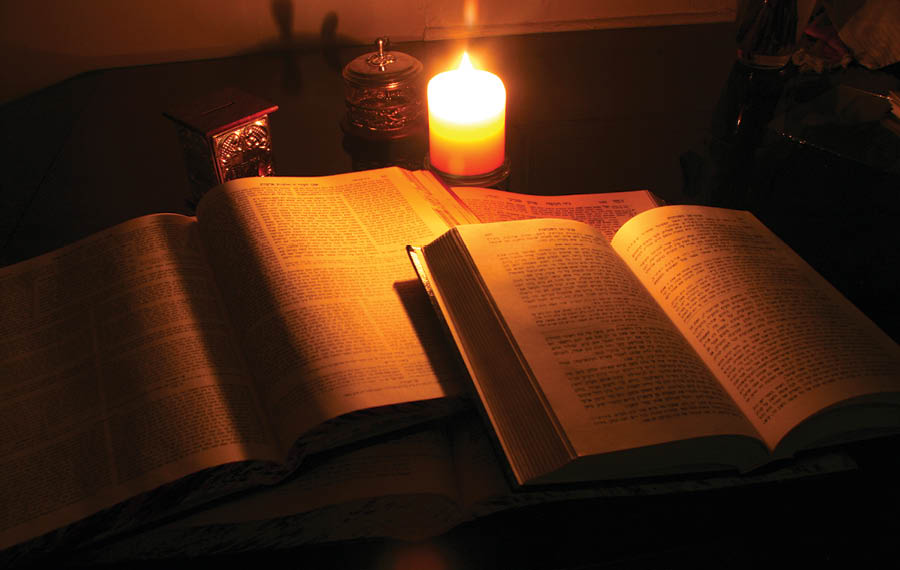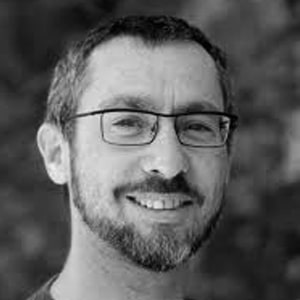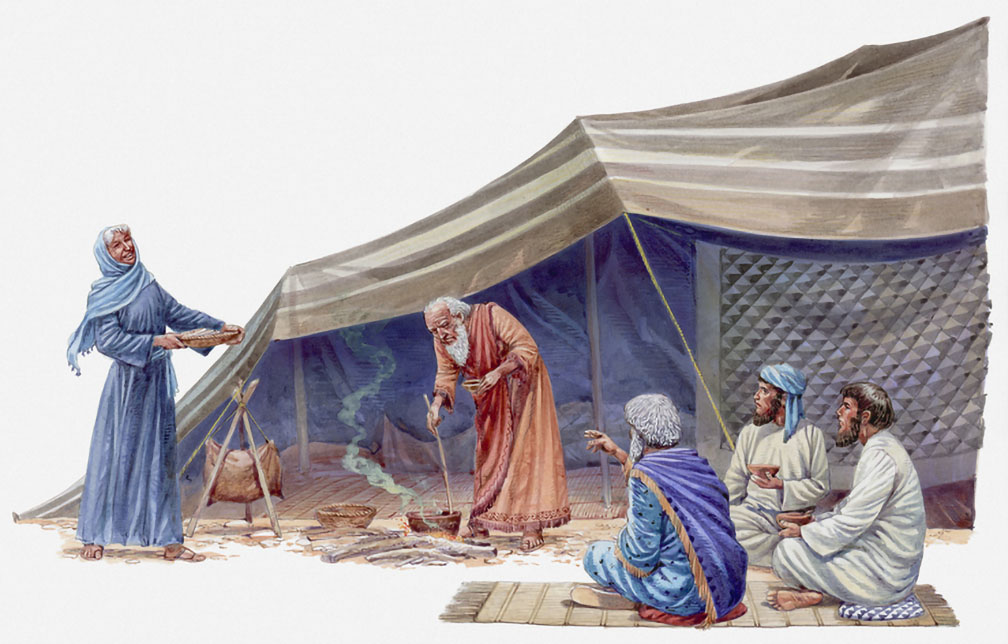
It is a commitment like few others.
These are the words that opened an article I penned seven and a half years ago. The time was August 2012. My soldier-sons were still in middle school. My middle-school daughter was still in preschool. My hair was still more brown than white. I did not yet write my two latest books. I was still driving a red Honda. I was still unaware of the possibility of Donald Trump ever becoming a US President. My late dog, Bubba, was still alive. My young dog, Layla, was not yet born.
In the Talmud a dog appears for the first time on the second page of the first tractate. Each night, says rabbi Eliezer, consists of three watches, of which the second begins when the dog barks. The second appearance of the dog is six pages later, and it presents an interesting twist. While Rabbi Eliezer utilizes a dog to separate the second watch of the night from the first watch – rabbi Meir utilize it to recognize the coming of a new day. When is the exact time in which the day begins? “Rabbi Meir says when one can distinguish between wolf and a dog”.
Seven and a half years ago, the day the article came out, I moderated a panel discussion in Jerusalem, to honor the ending of a cycle – and the beginning of a new cycle – of the Daf Yomi. Literally, “a page a day’’. That is, a page of the Babylonian Talmud, whom Wikipedia economically describes as “the central text of Rabbinic Judaism and the primary source of Jewish religious law and Jewish theology”.
2,711 pages in total. Seven and a half years. Day after day after day.
The panel in Jerusalem included a well-known Israeli scholar: Prof. Avigdor Shinan. As we were gathering to speak about the Talmud and its wonders, he was celebrating a personal triumph. A mission accomplished. Shinan read the last words of the last tractate of the Talmud, and then delivered the cryptic text customarily recited when a tractate ends. “We will return to you, Tractate Niddah, and you will return to us; our mind is on you, Tractate Niddah and your mind is on us; we will not forget you, Tractate Niddah, and you will not forget us – not in this world and not in the next world”.
The modern study of Daf Yomi was initiated more than ninety years ago by a rabbi named Meir Shapiro. He introduced the idea on August 16, 1923, and the first cycle of study commenced a few days later, on the first day of Rosh Hashanah. Ten years later, Shapiro passed away, leaving behind no children. Yet his legacy marches on. This coming shabbat, the 13th cycle of the Daf Yomi comes to an end. Many thousands of Jews around the world will join together in reading the last words of the last page: “The school of Elijah taught: Anyone who studies halakhot every day is guaranteed that he is destined for the World-to-Come…”
At that Jerusalem panel, Shinan, without knowing, convinced me that I must begin. His face lit up as he was reading the last words, and his shoulders seemed to have straightened. I wanted to have such feeling. I wanted to join a discussion that would be the opposite of an instant-gratification social media discussion. I wanted to take a journey that is the antithesis of today’s collective attention deficit disorder.
So, the next day, I started reading.
*
The Talmud begins with a seemingly simple question: “From when does one recite Shema in the evening?”
Of course, nothing in this question is simple. Nothing in the Talmud is simple. And the answer to the question is not really an answer. It is a few answers. The Talmud begins with Machloket – a disagreement. Rabbi Eliezer (the one of the night watch dog) says this, Rabban Gamliel says that, other rabbis have a third opinion. That’s a routine of the Talmud: Everything is up for debate.
Then we get a story: Rabban Gamliel’s sons return late at night from a wedding. They did not yet recite the Shema. Maybe it was the celebration, maybe the booze, maybe both. What shall they do? Their father says to them: If the dawn has not yet arrived, you are still obligated to recite the Shema. Now you know why a few pages later rabbi Meir (of the morning dog) will need a sign with which to identify when the day begins.
There is more than one Gamaliel in the Talmud. The one in our story is probably the great-great-grandson of Hillel the Elder, and the first leader of the Sanhedrin (the Jewish High Court) after the fall of the Second Temple in year 70CE. The most famous story about him chronicles a dispute between him and Rabbi Joshua on the exact time of Yom Kippur. Gamaliel, the senior among the two, commands Joshua to appear before him on the day Joshua believes to be Yom Kippur, carrying his stick and money. He wants to make the point that the authority of the court trumps all personal beliefs. It is final.
The Talmud is rich with such stories, some of which are astonishing, some just weird. But for the most part, the Talmud is not a corpus of stories, it is a transcription of many unfinished discussions and debates. “A highly discursive text, proceeding primarily by association rather than by any rational scheme”, wrote Ilana Kurshan in her masterful “If all the Seas Were Ink”.
Kurshan’s book mixes the story of her personal journey of crisis and growth, with the narrative of a daily study of Talmud. It is one of two books I am involved with that were published in Israel to coincide with the end of the Daf Yomi cycle. The second is a Hebrew original by Uri Briliant, whose title, tongue in cheek, is: All the Talmud on One Foot.
You are probably familiar with the story that beget this headline, also from the Talmud. There was a gentile who came before Shammai and said to him: Convert me on condition that you teach me the entire Torah while I am standing on one foot. Shammai pushed him away with the builder’s cubit in his hand. Then the gentile came before Hillel, who converted him and said to him: That which is hateful to you do not do to another; that is the entire Torah, and the rest is its interpretation. Go study.
One can find in the Talmud many sayings and life lessons such as this that can serve us all as we go about living our modern lives.
This short punctual story became quite famous. Much more famous than the similar, yet more complicated story that immediately follows it, about a gentile who asked to be converted to become the High Priest. It is famous because it’s simple. It is famous because it conveniently carries a modern message. Today’s readers see Shammai as the epitome of the rigid rabbinic rejectionist. Hillel is the inclusive, pluralistic nice guy. Shammai pushes people away, Hillel brings them in and sets what could seem as a low bar for participation: That which is hateful to you do not do to another. No keeping of difficult laws, no following Halachic rules, no paying attention to rabbinic decrees. Do no harm – that’s the whole Torah.
One can find in the Talmud many sayings and life lessons such as this that can serve us all as we go about living our modern lives. Hillel and Shammai are the sages whose great debates enriched us with the crucial teaching, the basis of all fruitful Jewish debates: “Divine Voice emerged and proclaimed: Both these and those are the words of the living God”.
Another example: In tractate Sanhedrin, we find this most vivid portrayal of a humanistic lesson: “the supreme King of kings, the Holy One, Blessed be He, stamped all people with the seal of Adam the first man, as all of them are his offspring, and not one of them is similar to another. Therefore, since all humanity descends from one person, each and every person is obligated to say: The world was created for me, as one person can be the source of all humanity, and recognize the significance of his actions”.
But one must not fall into a honey trap. The Talmud is not always an easy-going corpus of easily digested stories. In fact, it is often the opposite. It is direct and often cruel. It is alien to the modern ear as can be imagined. There is slaughter, and incest, there is beating, executions, bizarre ritual. If you think a do-no-harm approach is the common theme of Talmud, read what happens to the wayward wife, when she is forced to drink the bitter water that would reveal her guilt of unfaithfulness: “She does not manage to finish drinking before her face turns green and her eyes bulge, and her skin becomes full of protruding veins”.
Is this shocking? The Talmud could be, and often is, a shocking book. That’s one of the things I like about it. As one enters the gates of this tome – as I did every day, for about an hour – one must suspend preconceived beliefs and must suppress present-day sensitivities. In the strange world of Talmud the rules are different.
Sometimes they are different in a relatively innocent way, as in the many tractates in which the rabbis discuss how ritual was conducted at the Temple. Sometimes they are different in a puzzling way, as in the stories about brothers of the deceased that are expected to marry their sisters in law. And sometimes these rules are incomprehensible. Consider a relatively mild example, from tractate Shevuot: Rav Yosef teaches that from the Torah verse ‘But in righteousness shall you judge your colleague’ what we learn is that a judge ought to treat favorably a person who is “with you in observance of Torah and in fulfillment of mitzvot”. That is, favoritism in the court.
Is this what the Talmud really teaches, an unjust system of law? Of course not. The story is more complicated. It is complicated by the fact that the meaning of “justice” and human understanding on how to achieve justice changes with time. This means that Talmudic justice will not be always compatible with the proclivities of the modern reader. As in this case: There was an incident where two people dispute the ownership of property. One of them said: It belonged to my ancestors and I inherited it from them, and another one says: It belonged to my ancestors and I inherited it from them. What should the court do? “Rav Naḥman said: Whoever is stronger prevails”. The stronger of the two (the word the Talmud uses is “violent”) gets the upper hand. You can read this (unfavorably) as cavemen mentality. You can also read this (favorably) as humility – a realistic acknowledgment of the sages that the courts do not always have a remedy for disputes.
That is to say: Comforting Hillel stories aside, the Talmud is an unvarnished version of an unrestricted Jewish discussion of all matters. It is as far from the “safe space”, demanded by American students today, as one can get.
****
Seven and a half years ago, my father in law was still alive. A few days before he died, as I was sitting with him for what turned to be our last conversation, Yoram asked me to show him my iPad, and the page I was studying. It’s not clear to me what interested him more: the short Talmudic discussion, or the app with which I study. Either way, it was tractate Rosh Hashanah and I showed him that I was just looking at the well-known saying: “Rabbi Kruspedai said that Rabbi Yoḥanan said: Three books are opened on Rosh HaShana: One of wholly wicked people, and one of wholly righteous people, and one of middling people”, those whose good and bad deeds are equally balanced.
There is great debate in the Talmud, and also among the commentators who followed, who are the righteous and who are the wicked and who are the ” middling people”. As I was sitting with Yoram I shared with bits and pieces from this argument. He listened somewhat impatiently for a few minutes, and then blurted: “middling people is everyone”. About a week later, at his funeral, my eulogy included this anecdote followed by a description of what I think was one his most endearing qualities. “Yoram suspected the righteous. He was generally a little suspicious of any kind of displayed grandeur but found the overly righteous particularly suspicious”.
“Do not be overly righteous” is also a Talmudic saying, from tractate Yoma. Another example of a story that ought to make us cringe. It is a creative interpretation of a biblical story whose beginning does not reveal its tragic end. Samuel the Prophet commands Saul to “go and smite Amalek”. Saul does as he is commanded: “And Saul came as far as the city of Amalek and set an ambush in the valley”. But this is precisely where the Talmud intervenes and describes the battle as a twisted affair from the start.
The Talmud tells us that a bitter confrontation between Saul and God preceded the battle. Saul is averse to obeying the command to slaughter the Amalekites. How can a merciful god expect me to slaughter men, women, old people, children and livestock indiscriminately, the disgruntled king asks. His reward for this principled argument, the Talmud tells us, is a humiliating rebuff: “And a voice [from heaven] was heard saying: do not be overly righteous”.
What do you make of that? Once, researching for a book chapter about Jewish values, I learned that philosopher Samuel Hugo Bergmann had a hard time with Saul’s story and the conclusion arising from it. As a Jewish humanist, Bergmann was unable to agree with the command to destroy Amalek. That led him to write that “the principle has to be” that “wherever the holy text is at odds with my moral sensibilities, I must sacrifice the text and not my intellect or my sensibility”.
“Do not be overly righteous” is a talmudic saying from tractate Yoma. It is another example of a story that ought to make us cringe.”
Can a counter argument be made? Of course. But one of the quirky qualities of studying the daily page is that there’s no time for much philosophizing. One has to keep with the tight schedule – or fall behind. When I started studying, I was suddenly exposed to a world of people with horror stories about such falling behind after two years of study, or three, or five. That is, falling behind never to recover. Determined not to repeat their mistakes, one must nod to Saul and move to the next page. Yoma 23. Another day, another tragedy:
“An incident occurred where there were two priests who were equal as they were running and ascending the ramp” of the Temple’s great altar. Then one of them stepped into the path of his colleague, who then, out of anger, “took a knife and stabbed him in the heart”. Tractate Yoma is dedicated to the work in the Temple on the holiest day of Yom Kippur. And the Talmud chooses to tell us that the priests were so eager to fulfil their sacred mission that there was need to tame them. “Once they saw that the priests were coming to danger the Sages established a lottery”.
***
Back then, one needed a dog to bark in the middle of the night – today we have a watch. Back then, priests were running up and down the altar – today there is no altar. Back then, a husband could demand that his wife will drink the bitter water – today, thankfully, he cannot. So, why do it? What does one get from it?
The answer might be nothing. And that’s the whole point. As corny as this might sound, as one ponders the option of studying the Talmud, one must think about love. The love for one’s tradition (there is no Judaism without Talmud); the love for one’s forefathers and sages (they are as human as you can imagine); the love of study for the sake of study (no material or other benefit involved); the love of fierce intellectual discourse (Talmud debates can be extremely complicated); the love of the marathon (the Talmud is truly endless).
And apropos love, in tractate Kidushin, whose main theme is the laws of marriage, we find an interesting question: “The Sages taught: If one has to decide whether to study Torah or to marry a woman, which should he do first?” As you can already expect, there is no one answer to this question (or it would not be a question). There are two. One, anonymous view: “He should study Torah and afterward marry a woman. And if it is impossible for him to be without a wife, he should marry a woman and then study Torah”. But then, there is the other view, of Rav Yehuda who quotes the sage Shmuel. “The halakha is that one should marry a woman and afterward study Torah”.
Another question follows: How can one find time for study, when one has to provide for his family? Rabbi Yohanan uses this colorful metaphor to make the point: “With a millstone hanging from his neck can he engage in Torah study?” The answer is, well, sometimes yes and sometimes no, depends on where you live, or, more accurately, on your financial situation. “This is for us”, the Babylonian sages say, “and that is for them”, the Jews of Israel. In Babylon there’s plenty, and a person can both provide for a family and study. In Israel of the early first millennia the conditions were such that a person cannot both carry his family and make time for Torah.
“The Talmud could be and often is a shocking book.”
Seven and a half years ago, alongside many other Jews, I pondered similar question: Will I find the time? Will it not interrupt with work and family? Will it not be too demanding? The day I made my decision, at that panel discussion in Jerusalem, I handed the microphone to Prof. Shinan and asked him: Will you start again?
Oh, no, he said. This is something you do not repeat in one lifetime.
Then he continued reciting the ending of the concluding text: “We give thanks before You, Lord, our G-d and G-d of our fathers, for you gave us a share among those who sit in the study hall, and not among those who sit on street corners. For we arise early, and they arise early; we arise for words of Torah, and they arise for words of emptiness. We work, and they work; we work and receive a reward, and they work and do not receive a reward. We run, and they run; we run towards eternal life, and they run to a pit of desolation…”
***
This cycle of the Daf Yomi ends on Shabbat, the seventh of the month of Tevet, January 4, 2020. The next cycle begins the next day (January 5) and ends on Monday, the second of the month of Sivan, June 2, 2027. The quotes from the Talmud in this article were adopted from sefaria.org.il, an open online library of Jewish texts.
Shmuel Rosner is senior political editor. For more analysis of Israeli and international politics, visit Rosner’s Domain.His book, #IsraeliJudaism, Portrait of a Cultural Revolution (with Prof. Camil Fuchs) is available on Amazon.




















 More news and opinions than at a Shabbat dinner, right in your inbox.
More news and opinions than at a Shabbat dinner, right in your inbox.